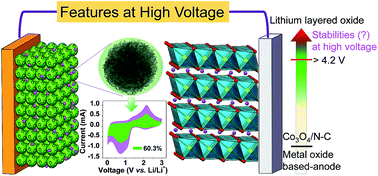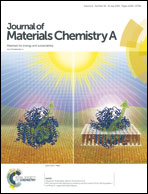Unique Co3O4/nitrogen-doped carbon nanospheres derived from metal–organic framework: insight into their superior lithium storage capabilities and electrochemical features in high-voltage batteries†
Abstract
The development of versatile strategies to create new structured materials via heteroatom doping has become a fascinating research topic owing to their fantastic properties, while the popular metal–organic framework opens promising avenues for the design of diverse architectures. Herein, an intriguing type of spherical N-doped porous carbon (i.e., N–C) particles containing numerous Co3O4 nanocrystals (i.e., Co3O4/N–C) is introduced, in which the Zn–Co based Prussian blue analogue acts as a sacrificial template and carbon source, while the volatilization of zinc and oxidation of Co produce rich pores and form highly active Co3O4 nanocrystals. The resultant Co3O4/N–C particles have an extremely high lithium storage capacity of 1255 mA h g−1 and excellent rate capability even at a current of 2000 mA g−1. Their long cycle life of over 500 cycles at 1000 mA g−1 with a high capacity of 798 mA h g−1 further demonstrates their prominent properties. Our kinetic analysis reveals that the high performances of Co3O4/N–C beyond the theoretical values mainly stem from the active Co3O4 nanocrystals, fast diffusion of lithium ions within its structure and its pseudocapacitive behaviors. Furthermore, the Co3O4/N–C particles also demonstrate impressive stability and rate capabilities in a lithium-ion battery versus a cathode of lithium layered oxide even at high voltage conditions.



 Please wait while we load your content...
Please wait while we load your content...